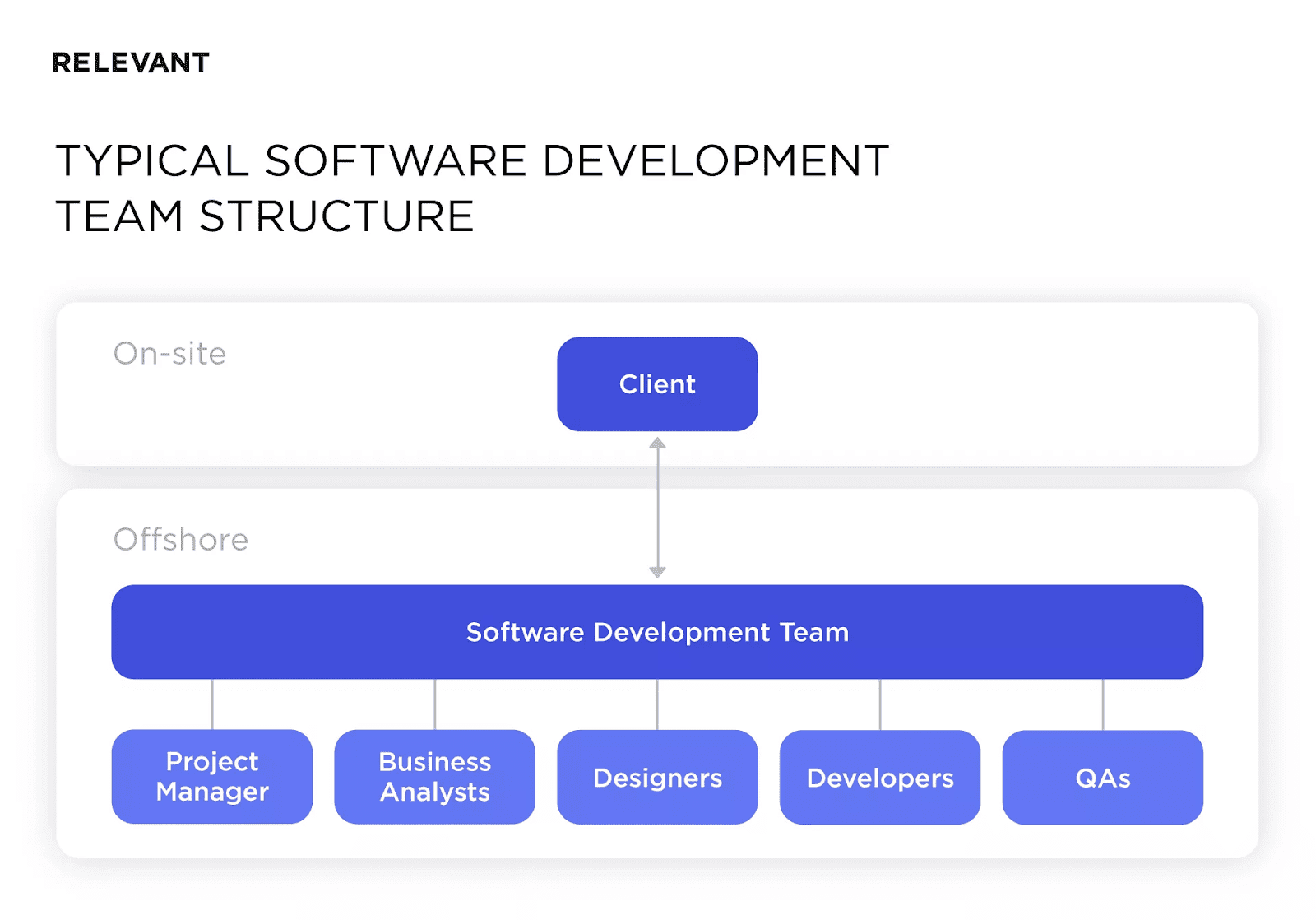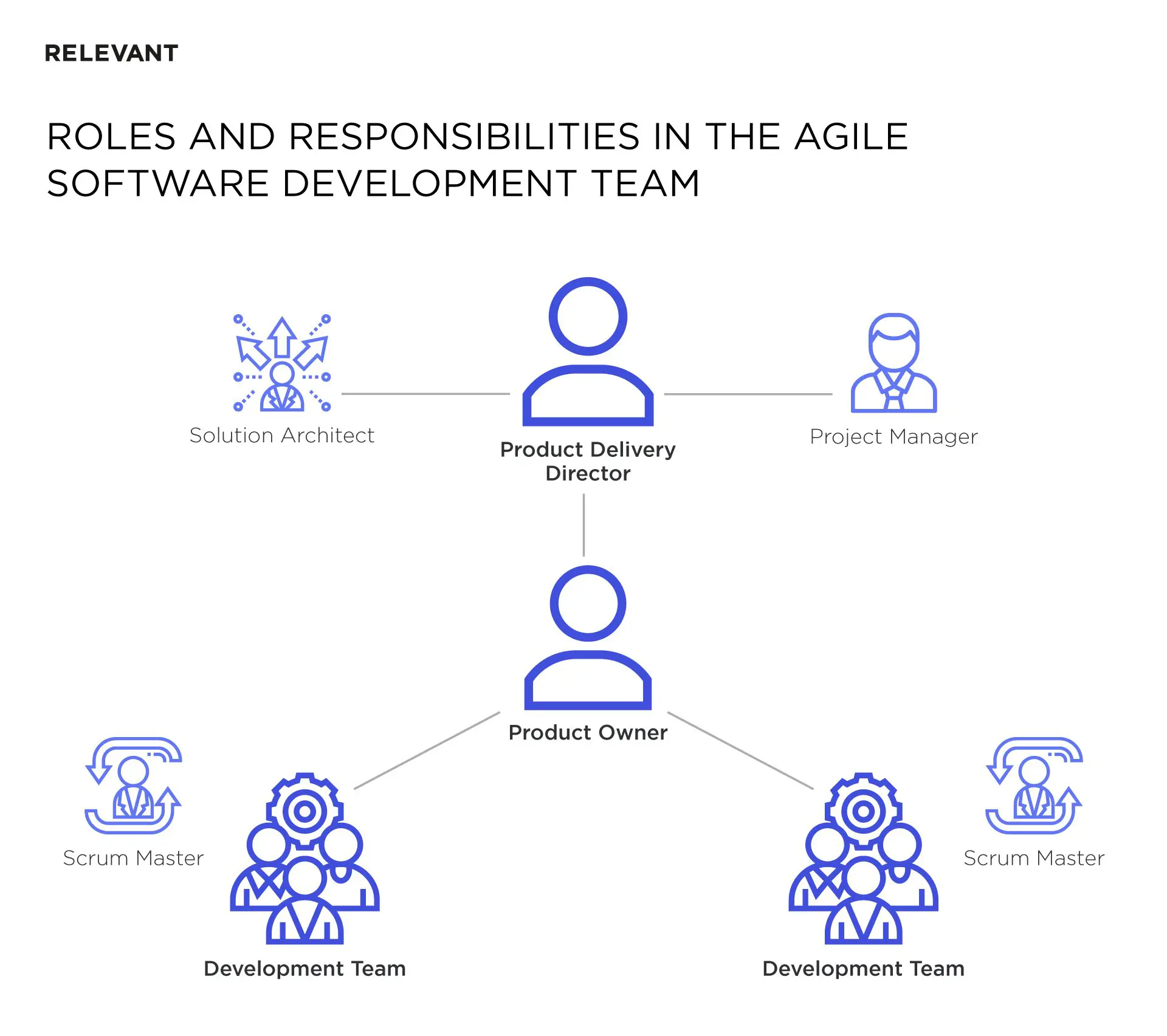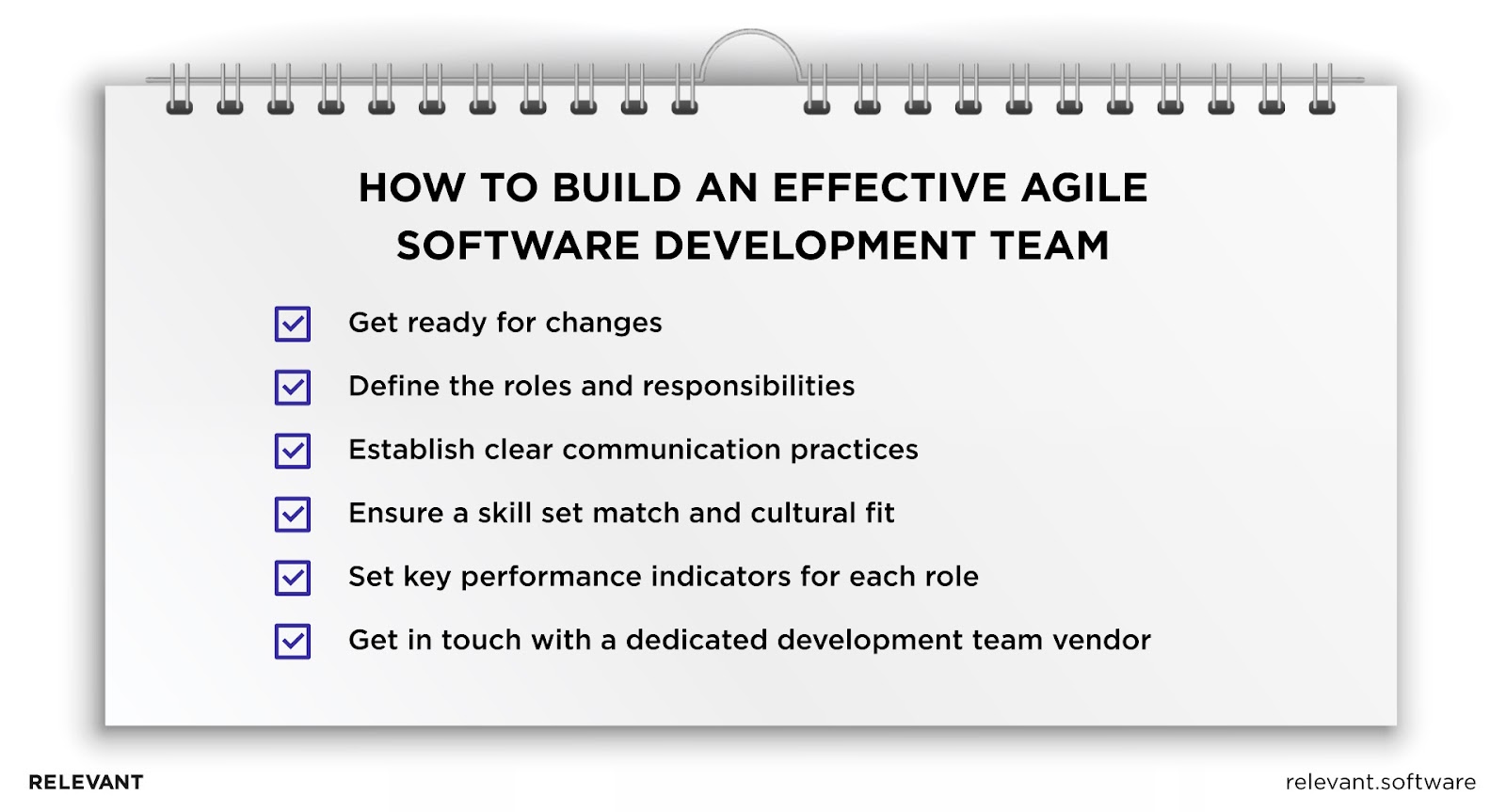Agile Software Development Team Structure: The 2024 Outlook

In our previous articles, we’ve walked you through Agile methodology and its key principles, discussed Agile development, and explored the compelling reasons for opting for a distributed Agile team. After familiarizing yourself with Agile, your next move would be to define team roles and scout for the ideal software development team structure to handle the tasks.
Remember, Agile is more of a conceptual model, and there isn’t a one-size-fits-all blueprint for structuring an Agile team—it hinges on your specific circumstances. Some entities favor a skill-based role division, adopting a hybrid approach, while others lean towards working with specialists.
For a more tangible understanding of an Agile software development team’s structure, we will share our experiences and insights from building such a team. If you’re seeking to maximize your results in a remarkably short time while being cost-effective, this article is specifically tailored for you.
Three Approaches to a Software Development Team Structure
As outsourcing becomes the norm for software projects, the buzz around optimal software development team structure has only grown louder. It’s a significant discussion; after all, the way a team is assembled and organized is pivotal to the project’s success. This structure outlines how team members collaborate and sets the pace for the project’s life cycle.
Various software engineering team structure models exist, each boasting its unique advantages and potential pitfalls. Traditional models, for example, adopt a hierarchical structure, providing clear accountability but potentially lacking in adaptability. Agile models, conversely, favor flat structures and cross-functional teams, offering adaptability at the potential cost of requiring a culture shift. In between these, we have hybrid models, combining traditional stability with agile flexibility.
But the software development organizational structure isn’t the be-all and end-all. Other factors, like team size, skill sets, project nature, and organizational culture, also weigh in. For instance, a small, skilled team might thrive in an agile setup, while a larger, diverse team might favor a hierarchical structure. Outsourced projects bring additional considerations, like geographical distribution of the team, time zone differences, language barriers, and communication styles.
Yet, we do have three primary frameworks at our disposal that can guide your decision-making. They are as follows:
- The Generalist Approach
- The Specialist Approach
- The Hybrid Approach
These approaches come with unique advantages depending on the demands of your project and organization. So, gear up to investigate these paths and find the one that best fits your context!
Generalist
Generalist team members juggle varied responsibilities instead of narrowing them down to one specific area. These are men of all work boasting a wide skill set, prepared to tackle any task.
Typically, generalist teams in software development either focus on a single project feature or take responsibility for the full-cycle development. This structure is often the go-to when engaging with third-party development teams.
Generalist Approach Pros:
- Flexibility: Generalists can adapt to various tasks, making the team more resilient to changes in project requirements or unforeseen challenges.
- Holistic Understanding: With a broad skill set, generalists have a comprehensive view of the project, facilitating better decision-making and problem-solving.
- Reduced Dependency: Since each member can perform various tasks, the team isn’t heavily reliant on one person for a specific role or skill.
Generalist Approach Cons:
- Lack of Specialization: While generalists can perform various tasks, they might lack the depth of knowledge that specialists possess, potentially impacting the quality of highly specialized tasks.
- Overwhelm: Juggling multiple responsibilities might lead to workload issues, affecting the team members’ focus and productivity.
- Time Management: With a broad scope of work, it may be more challenging to manage time and prioritize tasks effectively.
Specialist
In stark contrast to the generalist approach, specialist teams are composed of experts, each bringing a specific skill set to the table. Every member is dedicated to tasks within their area of expertise.
This is a match made in heaven for complex projects, where top-notch performance is non-negotiable, and any misstep could cost time and money. By opting for the specialist approach, you ensure that every challenge is addressed by an expert, eliminating concerns about issues slipping through the cracks.
Specialist Approach Pros:
- Expert Quality: Specialists bring a depth of knowledge and experience to their specific area, leading to high-quality outputs and expert problem-solving.
- Efficiency: As experts in their field, specialists can complete tasks more quickly and accurately, optimizing productivity.
- Less Training Required: Since specialists already have expertise in their area, they require less training, saving time and resources.
Specialist Approach Cons:
- Limited Flexibility: Specialists might struggle to adapt to tasks outside of their area of expertise, limiting the team’s flexibility.
- Dependency: The team could rely heavily on a specific individual in a particular task or skill, potentially creating bottlenecks.
- Cost: Hiring specialists can be more expensive due to their high level of expertise and demand in the market.
Hybrid
The hybrid approach is a fusion of the generalist and specialist strategies. Hybrid teams operate on the project in its entirety but can shift gears to apply their unique expertise when required. It’s a versatile mix, enabling you to tackle any Agile project with confidence and finesse.
Hybrid Approach Pros:
- Balanced Expertise: Hybrid teams enjoy the best of both worlds, combining generalists’ flexibility with specialists’ deep knowledge.
- Adaptability: They can respond effectively to a broad range of project needs, making them highly adaptable.
- Increased Creativity: The diverse skill set in hybrid teams often leads to innovative solutions and creative problem-solving.
Hybrid Approach Cons:
- Team Dynamics: It can be challenging to balance the strengths and weaknesses of generalists and specialists, which might impact team dynamics.
- Role Confusion: Without clear role definitions, there could be confusion about responsibilities, potentially leading to overlaps or gaps.
- Management Complexity: Managing a hybrid team can be more complex due to the team members’ diverse skill sets and varying work styles.
Typical Software Development Team Structure
Before we delve into an Agile team structure, let’s quickly revisit the software engineering team structure. In an ideal world, a team comprises a balanced mix of generalists and specialists, all seamlessly communicating and collaborating. However, factors such as time constraints, budget limitations, and other realities often prevent this ideal scenario. Hence, most teams today lean toward a generalist structure. So, what does this typically entail?

A conventional software development team usually includes roles such as:
- Project Manager: Oversees project planning, resource allocation, and progress tracking.
- Business Analyst: Converts business requirements into technical specifications.
- UI/UX Designers: Create the visual and experiential aspects of the user interface.
- Software Developers: Develop and implement the software by writing code.
- Quality Assurance Engineers: Validate the software through rigorous testing to ensure it meets quality benchmarks.
Each team member usually has a specific set of responsibilities tied to their roles, and the hierarchy is clearly defined.
The Unique Differentiators of the Agile Software Development Team Structure
Agile teams exemplify a unique strategy where the Agile methodology fosters multifaceted teams. In these dynamic groups, individuals are encouraged to take on a variety of roles and responsibilities that extend beyond their core area of expertise. This adaptive mindset fosters collaboration and enables team members to contribute across various domains, transcending traditional boundaries. Agile empowers teams to unleash their full potential, encouraging dynamic and versatile work environments.
Traditional Team vs. Agile Team
While a traditional team operates in a hierarchical structure with clear command lines, an Agile team is built on collaboration and self-management. Decisions are made collectively, and team members are encouraged to learn from each other and expand their skill sets.
Traditional teams often work in phases (e.g., analysis, design, coding, testing), completing each step before the next begins. Agile teams, on the other hand, work in sprints, with all stages happening simultaneously in each sprint. This iterative approach allows Agile teams to deliver workable products faster and readily adapt to changes.
In summary, the Agile software engineering team structure is less about rigid roles and more about flexible collaboration, breaking down silos, and promoting adaptability to change. Embracing this structure cultivates an environment that breeds innovation, propels delivery speed, and ultimately culminates in elevated levels of customer satisfaction.
| Traditional Team | Agile Team | |
| Leadership Style | The project manager calls the shots and controls the project. | The team is self-organized and self-directed. |
| Project Focus | The team might juggle multiple projects simultaneously. | The team concentrates on one project at a time for optimal results. |
| Performance Evaluation | Emphasis on individual performance and contributions. | The team’s collective performance holds significant value. |
| Team Size | No strict limits on team size. | Optimal team size typically ranges from 3 to 9 members. |
| Role Definition | A clear focus on job titles and defined roles. | Emphasizes skills and abilities over formal job titles. |
Remember, while this comparison highlights general tendencies, specific implementations can vary based on an organization or project’s unique context and needs.
[rws-cta id=”9776″]
Agile Software Development Team Roles and Responsibilities
In an Agile software development team, having a shared objective and clearly defined roles for each member significantly enhances productivity and facilitates the achievement of exceptional outcomes. Establishing responsibilities at the project’s inception ensures that all goals are met within the designated timeline and budget. The following are key roles typically found in the Agile team structure:
Product Owner (PO)
The Product Owner represents the customer’s perspective within the team. They possess a deep comprehension of the product vision and the business value that must be delivered The PO works closely with the team to prioritize the backlog, define user stories, and ensure that the team’s work aligns with customer needs and business objectives.
Scrum Master
The Scrum Master assumes the role of a facilitator and mentor to the team. They guide the team in understanding and applying Agile principles and practices, remove obstacles that could hinder progress, and ensure that the team functions smoothly. The Scrum Master also facilitates meetings like daily stand-ups, sprint planning, and retrospectives.
Development Team
The Development Team comprises skilled individuals responsible for delivering a potentially shippable product increment by the end of each sprint. This team is self-organising and cross-functional, including roles like developers, testers, designers, and sometimes even the Solution Architect, depending on the project’s complexity.
Front-end developers design the user interface’s aesthetics and usability, back-end developers manage underlying logic and database tasks, and DevOps Engineers ensure the secure, efficient development and deployment of software, thereby optimizing overall performance.
Product Delivery Manager
Not always present in every Agile team, the Product Delivery Manager oversees the product’s delivery from start to finish. They guarantee timely delivery of the product, adherence to the agreed budget, and attainment of the defined quality standards. They coordinate between the PO, the Scrum Master, and the Development Team to ensure everyone is aligned towards the same goal.
Solution Architect
The Solution Architect designs the system’s architecture and ensures it aligns with business needs and system requirements. They collaborate closely with the Development Team, guiding in implementing the planned architecture. In an Agile setting, this role focuses more on mentoring and empowering the team rather than imposing solutions.
Note. While our outlined roles are typically sufficient for a software team structure, large-scale projects may require additional positions. These could include domain experts and system integrators. This adaptation doesn’t dilute the Agile philosophy but enhances its applicability and efficiency in broader, more complex scenarios.
Your next read: Principal Software Engineer

Is an Agile Software Development Team a Suitable Fit for Your Business?
Before wholeheartedly embracing Agile in 2024, conducting an exhaustive analysis of its alignment with your organization’s needs is imperative. Contrary to common misconceptions, Agile is not a panacea for every business or project. Hence, your organization should meticulously weigh in on several determinants, such as:
- Flexibility and Adaptability: Agile teams thrive in dynamic and rapidly evolving environments. If your business operates in an industry with ever-changing requirements and priorities, an Agile team can provide the necessary flexibility to respond quickly and effectively.
- Collaborative Culture: Agile methodologies promote collaboration, open communication, and teamwork. If your business values cross-functional cooperation and encourages a culture of shared responsibility, an Agile team can align well with your organizational values.
- Customer-Centric Approach: Agile teams prioritize customer satisfaction and deliver value in short iterations. If your business emphasizes customer-centricity and values providing working software frequently to gather feedback, an Agile team can ensure that these needs are met effectively.
- Iterative Development and Continuous Improvement: Agile teams focus on incremental development and continuous improvement. If your business values an iterative approach to development, allowing for regular feedback, adaptation, and constant learning, an Agile team can support these practices.
- Project Complexity and Size: The agile approach suits projects with evolving requirements, high uncertainty, and complex solutions. If your business undertakes significant complex projects, an Agile team can provide a structured framework to manage and navigate complexity effectively.
- Organizational Readiness for Change: Adopting Agile SDLC methodologies often requires a cultural shift and organizational change management. If your business is open to embracing new ways of working, empowering teams, and challenging traditional hierarchies, an Agile team can help drive this transformation.
- Resource Availability and Skills: Agile requires a team with a diverse set of skills and the ability to work cross-functionally. Assess if your business has the necessary resources and skilled personnel ready to engage in a collaborative, multifaceted Agile environment. Consider whether there’s a need for additional training or hiring to fill any skill gaps.
- Leadership and Management Support: The success of Agile methodologies is significantly influenced by the support from leadership and management. Evaluate if your leaders and managers are willing to embrace Agile principles, provide the necessary support for Agile teams, and adapt to a more facilitative leadership style. This includes being open to changes in traditional management approaches and trusting teams with more autonomy and decision-making power.
Ultimately, the decision to adopt an Agile software development team depends on your business’s specific needs, project requirements, and organizational readiness for change. Careful evaluation of these factors will guide you in determining whether an Agile team is the right fit for your business.

Key Insights for Building an Effective Agile Software Development Team
Building a proficient Agile team in 2024 isn’t a breezy endeavor; it demands strategic foresight, unwavering dedication, and a willingness to welcome transformation. However, with determination, it’s not as daunting as it may initially seem. Moreover, armed with our seasoned guidance, the entire process will become significantly more manageable. Here’s a short roadmap for your journey:

- Adopt Agile’s Change-Centric Approach. Agile is more than a strategy; it’s a philosophy that demands constant adaptation in software development team structure. It’s about preparedness for the unforeseeable.
- Define Roles Clearly. In Agile, roles are commitments, not mere titles. Everyone must understand their contributions and responsibilities within the project.
- Promote Open Communication. Agile thrives on constructive dialogue, idea sharing, and positive conflict resolution. It’s not optional; it’s essential.
- Embrace a Continuous Learning Culture: Agile teams must be learning-oriented, continuously improving their skills and processes in their agile software development team structure. This involves regular retrospectives to assess what works and what needs improvement, fostering a culture of ongoing learning and development.
- Use Key Performance Indicators. KPIs are the pulse of an Agile team, providing measurable performance data and fostering continuous improvement. They’re indispensable.
- Engage a Development Team Vendor. Assembling an Agile team can be daunting. If so, consider partnering with a reliable vendor who understands the intricacies of software development team structure. They can provide an experienced Agile team, saving you time and resources. It’s a wise strategic move.
- Foster Team Autonomy and Empowerment: The Agile team structure performs best when they have the autonomy to make decisions about their work. Empower your team by delegating decision-making authority and encouraging them to take ownership of their tasks.
- Incorporate Agile Tools and Technologies: Utilize Agile project management tools and technologies that facilitate collaboration, transparency, and real-time progress tracking in the software team structure. This can include Kanban boards, Scrum tools, and digital collaboration platforms.
- Ensure Stakeholder Engagement: Agile projects succeed when stakeholders, including clients and end-users, are actively engaged throughout the process. Regularly update stakeholders and involve them in key decisions to ensure the product meets their needs and expectations.
- Balance Flexibility with Structure: While Agile is flexible, having a structured approach to manage this flexibility is crucial. This involves defining sprint lengths, setting regular meeting schedules, and establishing clear process guidelines.
- Invest in Agile Training and Coaching: To effectively implement Agile, invest in training and coaching for your team. This can include Agile methodology workshops, certifications, and hiring Agile coaches to guide your team through the transition.
- Customize Agile to Fit Your Organization: Agile methodologies are not one-size-fits-all. Customize Agile practices to fit your organization’s unique context, industry, and project needs. This customization should be an ongoing process, adapting as your team and projects evolve.
By adhering to this strategic roadmap, you will realize your aspirations of swiftly launching your product in the market and align yourself with the worldwide movement of embracing flexibility and collaboration.
Characteristics of an Effective Software Development Team Structure
As you already understand, the success of software development projects hinges on a well-structured team. The team’s composition, organization, and dynamics significantly influence project outcomes. Understanding the critical characteristics of an effective team structure empowers organizations to unleash the power of synergy and drive projects to triumph. This subparagraph explores the essential traits defining an efficient software development team structure.
- Clear Roles and Responsibilities: Everyone in the team knows their roles and responsibilities. This clarity prevents confusion and overlap of duties while ensuring that all aspects of the project are adequately covered.
- Balanced Skill Sets: The ensemble comprises individuals possessing distinctive yet complementary talents. Such versatility allows them to confidently confront numerous tasks and obstacles that might emerge throughout the project’s lifespan.
- Seamless Communication: The team configuration promotes effective interaction among all members. It ensures that everyone stays well-informed and in sync with the project’s evolution and emerging complications.
- Collective Spirit: This software engineering team structure fosters a collaborative space where thoughts and ideas are willingly exchanged, and each member’s contribution is esteemed. This sense of joint endeavor sparks innovation and problem-solving prowess.
- Flexible and Agile: The structure inherent to the software development team bolsters agility, enabling swift adaptation to shifts in project specifications or market circumstances.
- Guided Leadership: A potent presence ensures direction, aids in problem-solving, and guarantees that the team’s efforts align with the project’s goals.
- Accountability: Within the agile product team structure, every member is held accountable for their assigned tasks and responsibilities, fueling the overall triumph of the project.
- Continuous Improvement: The team structure encourages constant learning and improvement. That involves regular feedback sessions and retrospectives to identify areas of improvement and implement changes.
By embracing and embodying these essential traits, organizations can nurture their software development teams, enabling them to conquer challenges, achieve remarkable results, and flourish within the ever-evolving realm of technology.
Agile Software Development Team Structure: Summary
The Agile team structure emphasizes the strategic allocation of resources, ensuring that each member’s expertise is integral to the project’s success. By adopting an Agile software development team approach in 2024, you can achieve faster, high-quality product delivery while saving time and money.
At Relevant, we recognize the importance of team roles, so our software team structure blends Scrum principles with a tailored approach for each client. We value skills but prioritize working with specialists who excel in their respective fields.
If you’ve been searching for a dedicated team to develop your software without compromising time, money, or resources, it’s time to consider Relevant. Don’t hesitate to reach out to us for any queries or if you wish to deliberate over the nuances of your upcoming project. We’re here to make the complex straightforward.



